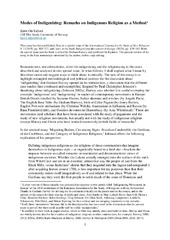Modes of indigenizing: remarks on indigenous religion as a method
Permanent lenke
https://hdl.handle.net/10037/18243Dato
2019-10-23Type
Journal articleTidsskriftartikkel
Peer reviewed
Forfatter
Tafjord, Bjørn OlaSammendrag
Romanticisms, not colonialisms, drive the indigenizing and the religionizing in the cases described and analyzed in this special issue. In what follows, I shall explain what I mean by this observation and suggest ways to think about it critically. The task of this essay is to highlight entangled methodological and political contexts for the discussion about “indigenizing” that Graham Harvey opened in his introduction, a discussion that the different case studies then continued and exemplified. Inspired by Paul Christopher Johnson’s theorizing about indigenizing (Johnson 2002a), Harvey asks whether it is useful to employ the concepts “indigenous” and “indigenizing” in studies of contemporary movements in Europe: British Druids (studied by Suzanne Owen), Italian shamans and witches (by Angela Puca), The English Bear Tribe (by Graham Harvey), Irish or Celtic Pagans (by Jenny Butler), English Powwow enthusiasts (by Christina Welch), Anastasians in Lithuania and Russia (by Rasa Pranskevičiūtė), and Goddess devotees in Glastonbury (by Amy Whitehead). These are movements (and scholars) that have been associated with the study of paganisms and the study of new religious movements, but usually not with the study of indigenous religions (except Harvey and Owen who have worked extensively in both fields of research).1
Forlag
Equinox Publishing LtdSitering
Tafjord, B.O. (2019) Modes of indigenizing: remarks on indigenous religion as a method. International Journal for the Study of New Religions, 2019,, 303-327. http://dx.doi.org/10.1558/ijsnr.37626Metadata
Vis full innførsel
© Equinox Publishing Ltd. 2019


 English
English norsk
norsk